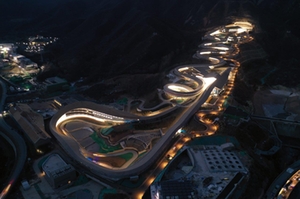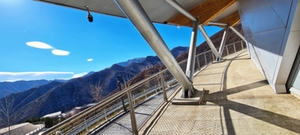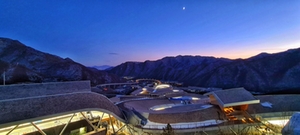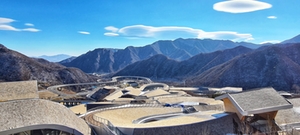The Olympic track - cool dragon

Beijing (FIL) The ice track architect Uwe Deyle has been allowed to live out his creativity at the Yanqing National Sliding Center.
The first meeting is behind them. Afterwards, there is no talk of love at first sight. Instead, respect prevails. "The track is very unique, it is extremely long, has some difficulties, often there are no landmarks," says Wolfgang Kindl, two-time World Champion from Austria. "The track has one or two pitfalls," judges three-time Olympic Champion Felix Loch from Germany. His teammate, World Champion and overall World Cup winner Julia Taubitz, says: "You really have to get through the two start curves in the best possible way, because otherwise you can already throw everything away."
Austria's head coach Rene Friedl sums it up: "The character of the track is very special, unique and demanding from top to bottom. You need a lot of feeling."

All four are talking about the track at the Yanqing National Sliding Center, the track on which the Olympic luge races in Beijing will take place. Thomas Schwab, Vice-President Marketing of the FIL and Chairman of the Board of the German Bobsleigh and Luge Federation, calls it "the most spectacular sports facility we have ever built".
Uwe Deyle is responsible for this. The specifications for the architect from Stuttgart, who had also designed the Alpensia Sliding Centre in PyeongChang, were short and to the point. The ice channel at the Yanqing National Sliding Center should be good, he says. He then set about planning it. The result was a track of extremes: at 1583 metres, it is one of the longest in the world, with 16 curves to master. With a top speed of about 135 km/h, it is only slightly slower than the ice canals of Whistler or Altenberg.
What makes it special, however, is that it is completely covered. The design of the roof makes the track look like a dragon from above. However, the visual appearance was not the reason why the ice channel was roofed over. The track is located on a south-facing slope. "We have to shade the track to keep the energy demand as low as possible," explains architect Deyle. In order to meet this requirement of the FIL and IBSF sports federations, the weather protection system was thermally insulated using about ten centimetres of mineral wool.

Although 90 per cent of the ice channel is already shaded by the overhanging roof, there are additional sun sails. When these are lowered, the result is an elongated hall where spectators can walk or stand directly along the rink. This, of course, has cost.
The centrepiece of the Yanqing National Sliding Centre is the 370-degree roundabout. After entering, it first goes uphill with a gradient of eight per cent, or 6.5 metres. Until the exit after 216 metres of ride length, the track drops by 19.50 metres at 16 percent. This is a real roller coaster. Some tobogganists have also called the oversized building a station concourse.

Architect Uwe Deyle has relied on high lines from the very beginning. Already in the first curve the ride line is at a height of two metres, in curve two it is already three metres. "With high curves you can lose time without obviously getting into trouble," explains Deyle. At the World Cup races in November, Wolfgang Kindl realised: "The curves are extremely open, so you can ski a lot of lines. And in some passages you also have to work against your body feeling." Up to curve eight, the track always does something different than would be ideal, according to the architect. "You have to drive very precisely so that you don't lose too much time," he explains.

The Deyle architectural firm is the pioneer for artificially iced bobsleigh and luge tracks. Company founder Werner Deyle, as a specialist in refrigeration technology, had realised the ice speed skating track in Inzell in the mid-1960s. Richard Hartmann was also present at the inauguration. The then sports director of the German Bobsleigh and Sledding Federation approached Deyle: "What you have done here on the flat can certainly be tilted." This was the birth of the bobsleigh and luge track at Königssee, the first artificial ice track in the world, which was inaugurated in 1968. The facility was created at that time with empirical tests and support from the then national coach Sepp Lenz. Equipped with this know-how, other rinks followed.
As in the Alpensia Sliding Centre in Pyeongchang, Deyle has also installed a curve with two radii in the Yanqing National Sliding Centre. It starts with a jump followed by a dip as a pressure point. "We call it a sheep curve," he says.
Now that Uwe Deyle has successfully completed the Yanqing National Sliding Center project, the architect sums it up: "This is the coolest track you could wish for as a planner." Do the lugers think it's as cool? They will have their say in February at the latest.








